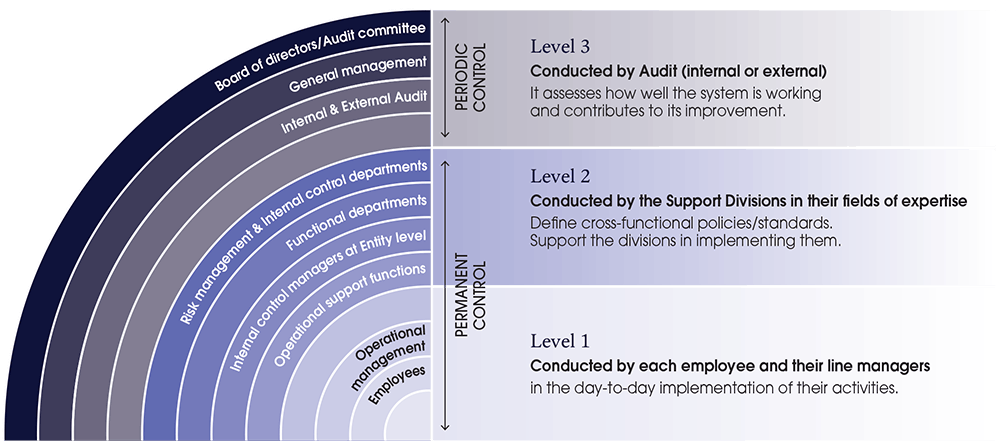Chapter 3 : Risk factors and risk management
3.2. Components of the Internal Control and Risk Management system3.2. Components of the Internal Control and Risk Management system

This diagram shows the components of the internal control and risk management system.
Permanent Control
Level 1
Conducted by each employee and their line managers, in the day-to-day implementation of their activities
- Operational management
- Employees
Level 2
Conducted by the support divisions in their field of expertise, define cross-functional policies/standards. Supports the divisions in implementing them
- Risk management and internal control departments
- Functional departments
- Internal control managers at Entity level
- Operational support functions
Periodic control
Level 3
Conducted by Audit (internal or external). It assesses how well the system is working and contributes to its improvement
- Board of Directors / Audit Committee
- General Management
- Internal and External Audit
3.2.1. Organisation and environment
The control environment is critical to the Internal Control system. It means risks can be managed well and procedures implemented. It is based on behaviours, the organisational structure and employees. At L’Oréal, it forms part of a culture of rigour and commitment communicated by senior management. This is in line with the Group’s strategic choices.
The Group’s Ethical Principles
L’Oréal’s development and reputation are built on strong Ethical Principles: Integrity, Respect, Courage and Transparency. The Group’s policies on sustainable development, social and societal responsibility, compliance and philanthropy are based on the Ethical Principles.
L’Oréal’s Code of Ethics is available in 45 languages and in Braille in English and French. It is distributed to all employees around the world. It uses simple rules and concrete examples to explain how they can apply these Ethical Principles in their behaviours and actions.
The Code of Ethics applies to all employees, directors and corporate officers and members of the Executive and Management Committees. Since 2010, 18 supplements to the Code of Ethics have covered certain aspects of it in more detail.
The Chief Ethics, Risk and Compliance Officer
The Chief Ethics, Risk and Compliance Officer reports directly to the Chief Executive Officer and keeps him informed on a regular basis. The Chief Ethics, Risk and Compliance Officer regularly informs the Board of Directors and the Executive Committee. His mission on Ethics is to:
- promote and integrate best practices within the Group, by facilitating ethical decision-making;
- oversee employee training;
- oversee the management of alerts and directly manage those related to senior management positions; and
- measure and assess the Company’s ethical performance.
They have a dedicated budget and team, and unrestricted access to all information about the Group’s business activities. They can call upon any of the Group’s teams and resources in the performance of their work.
The Ethics and Human Rights approach of L’Oréal and its stakeholders
Country Managers (or for Corporate or Zone staff, the members of the Group’s Executive Committee to whom they report) are responsible for ensuring compliance with the Code of Ethics. The Chief Ethics, Risk and Compliance Officer systematically meets each new Country Manager and the Group’s senior managers to provide guidance about their role. Senior managers also benefit from a tool to help develop their ethics leadership as well as specific training.
The 78 Ethics Correspondents throughout the world assist members of the Executive Committee and Country Managers to implement the Ethics programme. Led by the Group Ethics team, they provide all employees with a local point of contact. They promote the normal routes for handling concerns by Management and Human Resources.
The Chief Corporate Responsibility Officer, a member of the Executive Committee, oversees the respect of Human Rights and fundamental freedoms in the Group.
The ethical and Human Rights risks are mapped and regularly updated, which includes suppliers and subcontractors(see section 3.4.3.). Country Managers assess and analyse local ethical risks using a dedicated tool. They adopt the necessary prevention measures.
